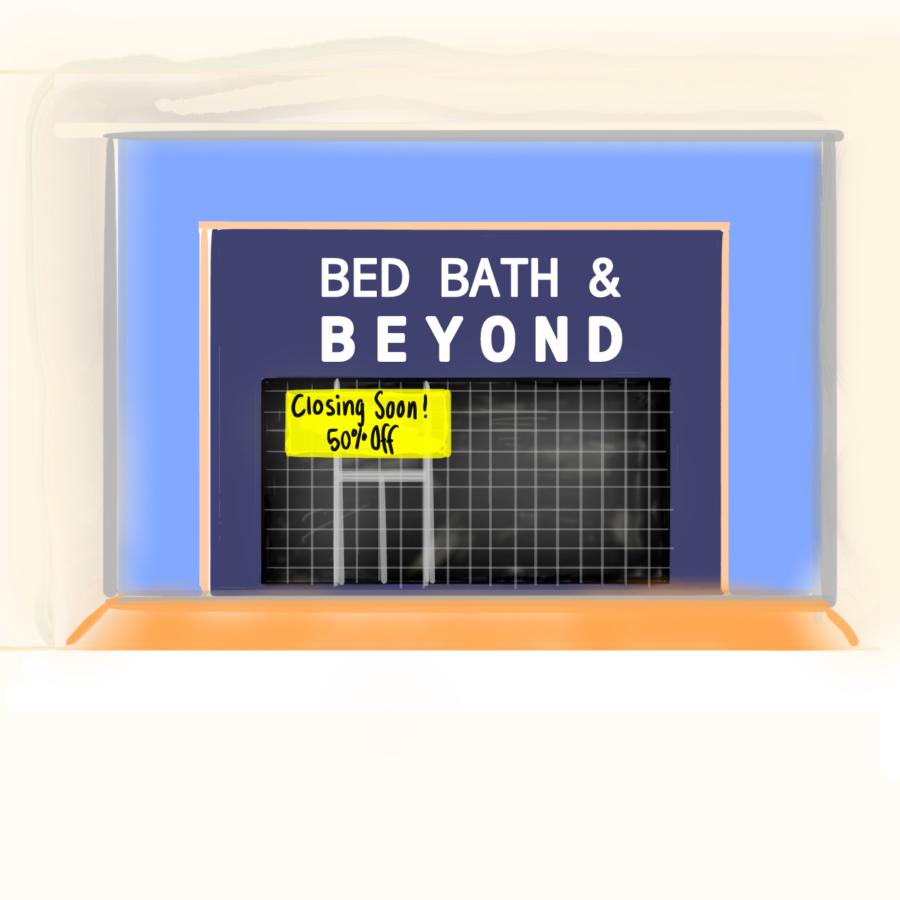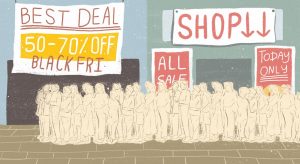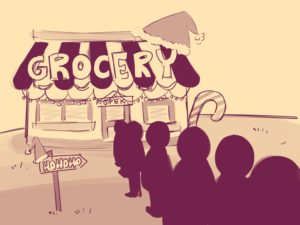The downfall of Bed Bath & Beyond marks the increasing damage to America’s social fabric
The department store chain Bed Bath & Beyond filed for bankruptcy on April 23rd, contributing to long lasting implications in shopping culture.
May 28, 2023
Bed Bath & Beyond is next in line for department store collapses. On April 23, the company filed for Chapter 11 bankruptcy protection, following through with its warning from early January of a potential financial collapse. Soon all 360 stores and 120 Buybuy Baby locations will have closed and liquidated their assets, making the every Bed Bath & Beyond, including the one on our local Hacienda Crossings, a bare building with a “Closing Soon” sign and letters that will be ripped off eventually.
The losses are numerically significant; the company had a 40% to 50% decline in comparable stolen sales in their fiscal fourth quarters of late March. It started with the development of e-commerce, and just like many other stores, Bed Bath & Beyond has faced the consequences of the height of online shopping. These statistics are popping up more and more in the retail industry during this age of technology, and a commercial property research firm even finds that more than half of all mall-based department stores will close by the end of 2021, hitting the American shopping mall system just as hard.
The losses aren’t just numerical, though. While most note that these trends represent the takeover of the technological world, they often don’t note the damaging social and emotional consequences of it. As Vox writes, stores like Bed Bath & Beyond were key in the “idea of shopping as a social activity in the second half of the 20th century.” But with shopping at the tip of a click on a keyboard, that human presence and interaction outside of home and the workplace goes missing. Opportunities for warm social feelings or new interactions with objects and people are replaced purely by a black screen. Ultimately, the loss of Bed Bath & Beyond represents the fall of another experience of family, connection, nostalgia and life milestones that occurs in the trend of end of shopping culture.
The height of the company occurred with economic reason; its unique coupon system made it strong enough to grow through the Great Recession. But it also occurred because of that exact culture mentioned before. The store appeared in popular culture, starring as a subplot in Comedy Central’s “Broad City” as well as movies, such as Adam Sandler’s 2006 “Click” where the main character starts by going to the store just to get a universal remote control, something he would have known is available at a store that seemed to have virtually everything for the home. That is another aspect of the culture it contributed to – convenience. Beth Grossfeld, who worked in marketing for the company for 13 years, talked about the experience of shopping in the store for customers.
“Floor to ceiling, stack ‘em high and watch ‘em fly – that was kind of our motto,” he told NPR News, “And the customers loved it. It was like a treasure hunt. You got what you wanted and 10 other things.”
That was more common in the 2000s, however; the Bed Bath & Beyond in Hacienda Crossings definitely isn’t a commonly visited department store destination for generations today – hence their bankruptcy as well – but it has always been an available, consistent option. With its blue hue and the piles of pillows, Bed Bath & Beyond felt like a dependable “home” store, that exact family idea that seems to fall now with e-commerce and quick, personal Amazon shopping carts. Even Bed Bath & Beyond CEO Sue Gove highlighted a similar sentiment in a press conference for the bankruptcy.
“Millions of customers have trusted us through the most important milestones in their lives — from going to college to getting married, settling into a new home to having a baby,” Gove said in their statement.
As each store falls, like Bed Bath & Beyond, Toys R’ Us, Nordstrom, the culture associated with those stores becomes weaker. Walking through stores and interacting with people all contributes to the “social and convivial” spaces, as Amanda Mull from the The Atlantic names it, in our towns, cities, neighborhoods and countries. We navigate the world and participate in it by just stepping out to even a singular department store.
“[Modern American] life is more satisfying when you can touch something before you buy it, when vendors near you sell things you might need at the last minute, when people in your community can gather in places to do the mundane errands and chores of living,” Mull adds in their article. “The centrality of these market spaces persists across time, culture, and geography, and it predates capitalism by millennia.”
And many people, such as Sabrina Helm, an associate professor in the Norton School of Family and Consumer Sciences at the University of Arizona, argue that allowing such shopping systems to fall changes our social systems as whole.
“Brick-and-mortar stores play an important role in consumers’ lives and society, and in most consumers’ minds, they should survive,” she told Futurity, a scientific research website.
Whether they are a store visited by many or one acknowledged by a few, each one is said to play a role. With Bed Bath & Beyond closing, another domino has been tipped in the chain reaction of the fall of the systems we are used to. Ultimately, there’s a sense that these stores can be appreciated for what some say they truly are; a contribution to the irreplaceable “social fabric” existent in American culture today.





